How to Add Information Gain to Your Content: 3-Phase Plan
Topic: SEO
Published:
Written by: Bernard Huang
Ready to transform your content inventory with information gain?
Imagine a treasure trove brimming with perspectives, reviews, testimonials, past research, and personal anecdotes waiting to be woven into your narrative of content specifically crafted for your customer’s search journey.
If this sounds like a lot of work, well, you’re right: It is.
But we’ll explain how to accomplish this in an easily-digestible three-part plan detailed in this article:
Organize existing primary-source or first-party data
Test and monitor outcomes
Take action on your learning… and capture more data
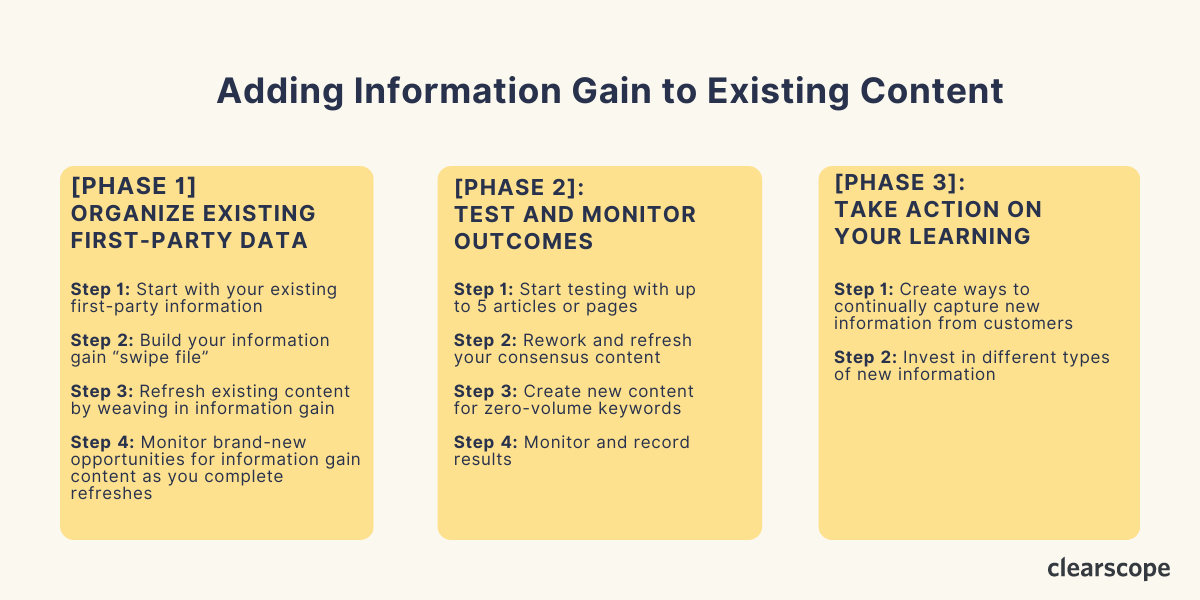
But first, let’s talk about valid reservations to taking on this kind of work.
(If you don’t have any reservations, go ahead and use the table of contents on the left to skip ahead to Phase 1.)
What if you have reservations about investing in information gain for SEO?
A pivot in search marketing philosophy is challenging, especially when this kind of content takes more time, resources, and creativity to produce.
But in the crowded landscape of digital content—and the advent of Google’s AI Overviews (formerly Search Generative Experience (SGE)) with AI being infused into organic search—standing out requires more than just a catchy headline, flashy image, and the right keyword coverage in consensus content pieces.
Enter the realm of information gain SEO—a concept that, when you do employ it correctly, uses your wealth of existing resources, customer insights, and the power of experimentation to craft content that not only shines, but also drives brand authority and trust.
And later? Results and search visibility. This is the long-term play.

Read more from Garrett over at iPullRank, including How To Optimize for AI Overviews (SGE).
However, there are some very real reservations and risks to creating information gain content—and the internet hasn’t yet figured out solutions.
Chrisy Toombs of Homemade Hooplah calls it out straight in her post that received over 65K views. We recommend you read the whole thing, but here’s an important snippet below:
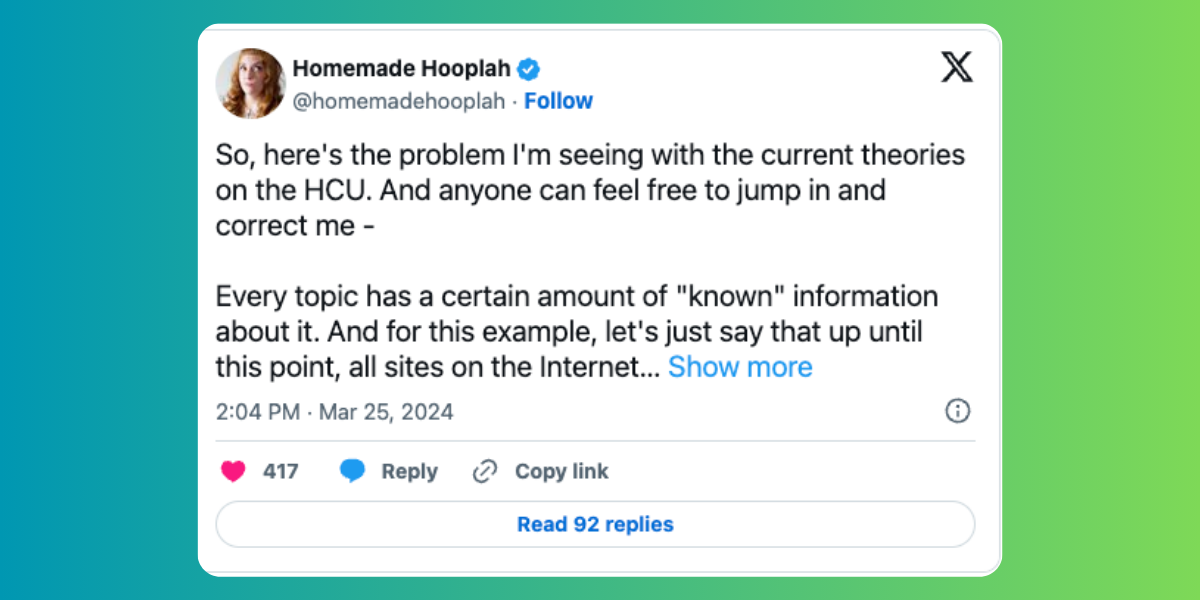
So what am I supposed to do now? Put more time and effort into creating something else that's amazingly unique just so it can be stolen by sites with higher authority than me, resulting in more $$ for them?
Does this not sound like just another richer-get-richer system?
The thing that has ALWAYS made the internet an amazing place is that you COULD have a seat at the table with these big players. Glass ceilings didn't exist; the only hurdle that existed was your own limitations of talent, effort, and commitment.
But if the above is at all true about how the HCU works, the best we can hope for is a 1-hour visitor's pass to the table - if we're even let into the building at all. And the price of that pass is HIGH. Truly unique content on a known topic is NOT as easy to create as some of the comments being thrown around suggest it is. For some topics, that's like asking them to find a new letter in the alphabet.
It's like the internet is finally going old-school boy's club corporate. Or, at least, that Google is using its power to try to make it that way.
With what we're seeing in search and what we're being told to do to fix it, I struggle to see how this plays out in any other way.
— Chrisy Toombs, Homemade Hooplah
This is a very real concern—one that Christy outlines superbly.
And we understand at Clearscope, too. It’s an interesting thing to serve both independent creators and publishers and large enterprise brands. And we strive to do it well.
However, we do all play by Big Search’s rules, for better or worse, whether a large site or small independent one. (Big Brands: Here’s your call and challenge to ethically source and site information gain produced by smaller content creators.)
If you’re still on the fence about investing in this kind of content creation, there are more benefits to creating information gain than just staying competitive in SEO by branching off of consensus or AI-generated content.
Read about them in Information gain in SEO: Your plain-language quick reference guide.
A few quick tips that may reduce initial reservations:
This is the way the internet is headed. AI-generated answers to search queries are already in Google’s search results, and they’re based on consensus content. Creating information gain content allows for greater chances at continued visibility—because this is something that LLMs cannot do.
Before going all-in, test adding information gain by refreshing old, existing content first to prove (or disprove) theories. It’s likely you plan on refreshing older content soon anyway.
Use your deep customer knowledge: Ask customers directly about what they want to learn and what content they appreciate the most. Giant publishers and established brands may have a wider reach, but if you’re a smaller site, it’s likely you’re in a niche that you know incredibly well. This can give you a competitive advantage.
Okay, now let’s dig into the Big Plan to start implementing information gain across your site’s content.
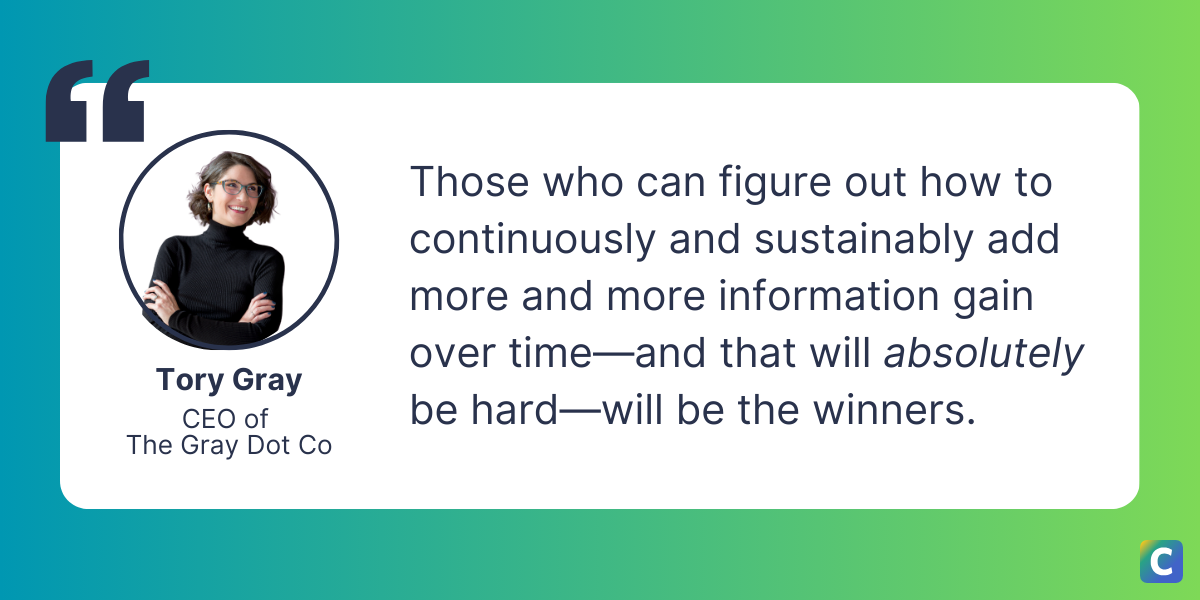
Phase 1: Organize existing primary-source or first-party data
Phase 1 is all about gearing up to make the existing consensus content across your site more unique.
Even if you’re a one-person operation, it’s likely you have first-party information on hand all over your digital office.
In Phase 1 of your Information Gain content plan, you’re going to create an “information inventory.” Here’s what you’ll do:
Start with existing first-party information.
Build your information gain swipe file.
Refresh existing content by weaving in information gain.
As you refresh, note net-new opportunities for information gain content. (I’ll show you what to look for below.)
An important note here: According to Kevin Indig of The Growth Memo, “I would take this a step further and push companies to do first-party research. Some of them also have existing product data that they can use to enrich content.”
I agree, and we’ll get there later in this article in Phase 3. However, for organizations that are hesitant in investing in first-party research at first, we’ll take a conservative test-and-see approach.
If your clients (or organization you work for, if you’re in house) are heavily invested in competitive SEO, you may be able to jump ahead and invest in new first-party research to add to new and existing content.
But for those who are unable…
Step 1: Start with your existing first-party information
This part of Phase 1 should cost you nothing to procure—except your time to gather it all up in an organized fashion.
You’ll likely find this already-existing information gain in:
Customer Reviews
Client testimonials
Questions from clients, coworkers, or customers that you’ve answered
Previously completed interviews
Brand videos
Past customer research surveys
Older case studies
Repeat questions in private Slack communities, on socials, or in forums like Reddit—wherever your target audience hangs out
Webinar recordings
Stories from real life—based on your own personal experience or the experience of your team and org leaders
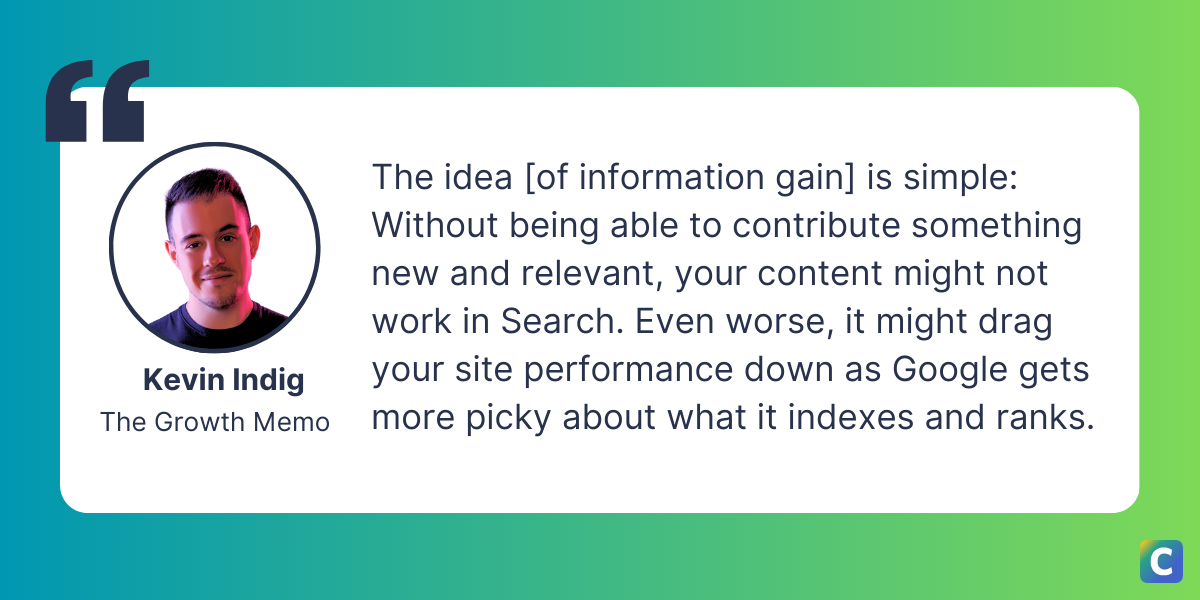
Step 2: Build your information gain “swipe file”
Call it what you will: An information gain library, a deck, or a swipe file, but here’s where you’ll build your inventory of gathered information gain assets and “copy snippets” that are unique to your organization or site—the kind of information that cannot be invented by AI.
In the past, I’ve used Google sheets because I can store these copyedited or stylized snippets with labels and notes, which makes them easily searchable for my team.
Make sure all your compiled information has squeaky-clean copy and is ready to be incorporated into external content.
Here’s a basic, templated version of what I’ve used in my own content strategy work over the years. (Feel free to steal and make it your own!)
Step 3: Refresh existing content by weaving in information gain
Here comes the fun part:
When it’s time to spruce up that older article in your content library, simply dig into your information gain swipe file to find primary data and quotes to weave into your existing work.
No additional interviews or surveys needed.
This could look like:
Adding quotes from past interviews or testimonials to support claims
Including a true story or first-person account into existing educational articles
Embed clips from previous webinar videos
Refer to previous or recent customer research; use that data to support existing content
With your prepared information gain library, infusing new information into existing content becomes more scalable.
It also becomes delegatable—meaning, you can better assign out this work to your broader team or outside freelancers—which is key if you’re doing this at scale across a large content inventory.
Step 4: Monitor NEW opportunities for information gain content as you complete refreshes
While you’re working on infusing and refreshing existing content with information gain, create a running list of new opportunities to tackle in Phase 3.
These opportunities can often look like:
Zero-volume keywords
Fresh, alternative perspectives in your topic niche
Plain-language summaries of industry studies with actionable insights
Low-importance keywords adjacent or related to your topic niche
If you’re a Clearscope user, here’s how to use the Clearscope Drafts feature to discover where you can add information gain to existing content.
You can also use this same feature to take note of fresh concepts that warrant entire new articles in your topic:
Phase 2: Test and monitor outcomes
Once you’ve refreshed your existing library to infuse a baseline of primary data that cannot be easily replicated by AI-generated search results, begin testing:
Refreshes and reworks of existing Skyscraper articles or consensus content
Creating net-new articles based on zero-volume keywords
We hope we don’t have to remind you of this, but when running these tests for existing content, do not use your “money maker” pages that are already performing the way that you want them to.
Run tests with low-stakes pages that already need rework.
If you’re here and you’re asking: Why? Why in the world would I do all this work to existing, older consensus content or larger Skyscraper articles?
Check out Bernard Huang’s Guide to Ranch-Style SEO to understand how this tactic can:
Create information gain
Build content that directly fulfills your target audience’s search intent
Hedge up your site against AI-generated answers to search queries
Here’s how to do Phase 2—there are four steps:
Choose your test subjects: I recommend starting with up to 5 pages.
Rework your generic content.
Go after zero-volume keywords with new content.
Monitor and record results.
Step 1: Start testing with up to 5 articles or pages
Choose 1-5 pages of content for testing. Bonus points if you’re beginning with older content that needs to be cleaned up or low-stake pieces that aren’t your top performers.
Before you break longer generic content pieces into more-targeted, deeply search-intent focused pieces content, record the following for each piece in a spreadsheet:
Ranking keywords for the URL
Number of Page 1 average positions placements (including noting top 3, top 5, and top 10 position placements, if any)
Estimated monthly organic traffic
# of monthly MQLs or form opt-ins for each
On-page engagement signals
Current content grade (if you’re using Clearscope)
Step 2: Rework and refresh your consensus content
Keep the original URL for your content, but refresh and rework your selected pages to add in that sweet, sweet information gain that you gathered in Phase 1.
If you’re working with an older, Skyscraper-style consensus content, you should move information that deserves its own content piece that better meets search intent to its own page.
For what it’s worth, Skyscraper content is a valid strategy and should still exist. But it’s not the only strategy.
For some queries, a skyscraper-style content piece may be the best fit. Do your search-intent research!
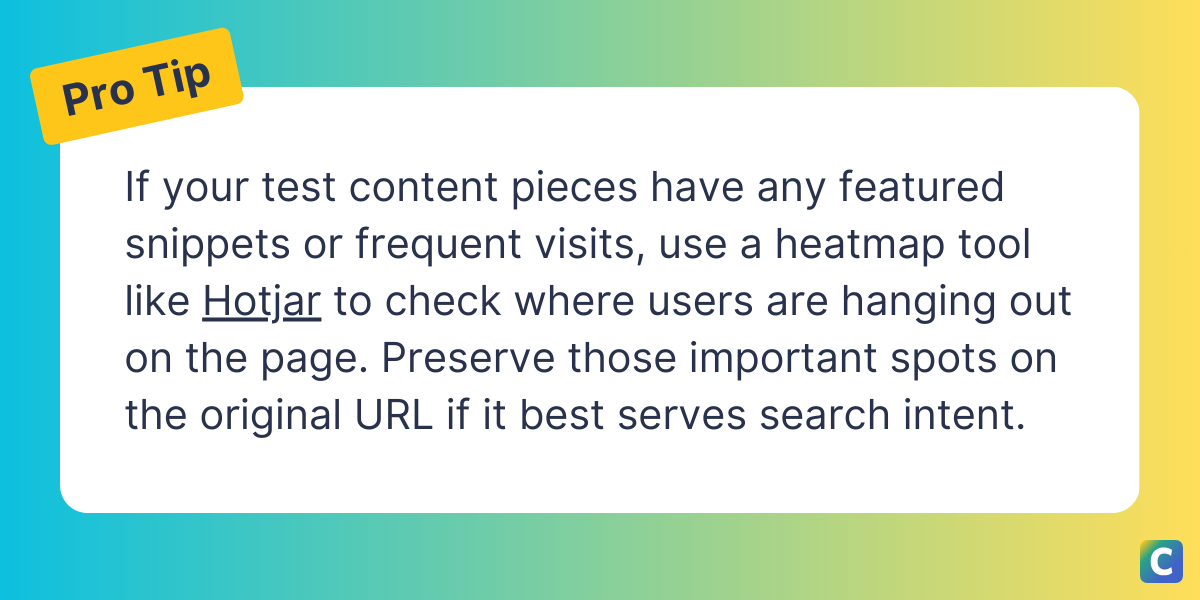
A quick note of caution here: If your test content pieces have any featured snippets or frequent visits, use a heatmap tool like Hotjar to check where users are hanging out on the page. Preserve those important spots on the original URL if it best serves search intent.
Example of a perspective-driven rework of consensus content
Check out 7 successful Ranch-style SEO content frameworks for inspiration as you rework your selected content pieces, but we'll look at one example here below.
(If you're already familiar with this concept, go ahead and skip this section.)
Let’s say we have a 3,000-word article titled “Everything You Need to Know About Bone Broth” living at a URL like [/resources/bone-broth-guide/] that employed the skyscraper tactic.
The existing content gives you a basic bone broth recipe along with including two sections that are about 800 words each; these sections cover the health benefits of bone broth and how to incorporate bone broth into intermittent fasting. The content also has a robust FAQ section.
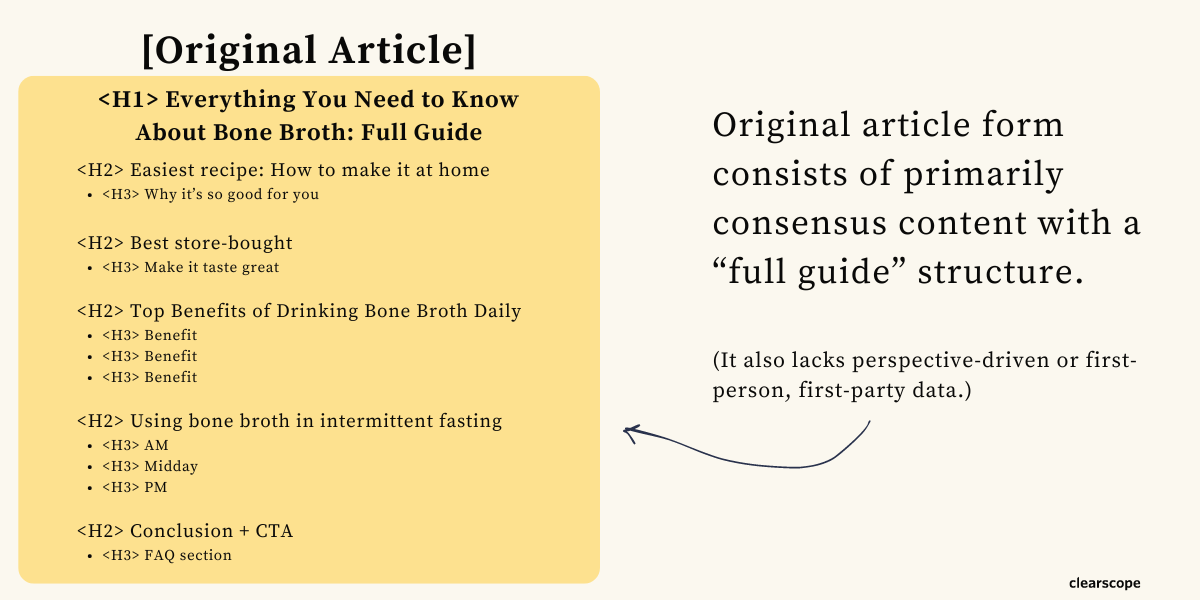
Perhaps you rework the article in the following manner to incorporate first-party data from your information gain swipe file and refine to more sharply meet search intent:
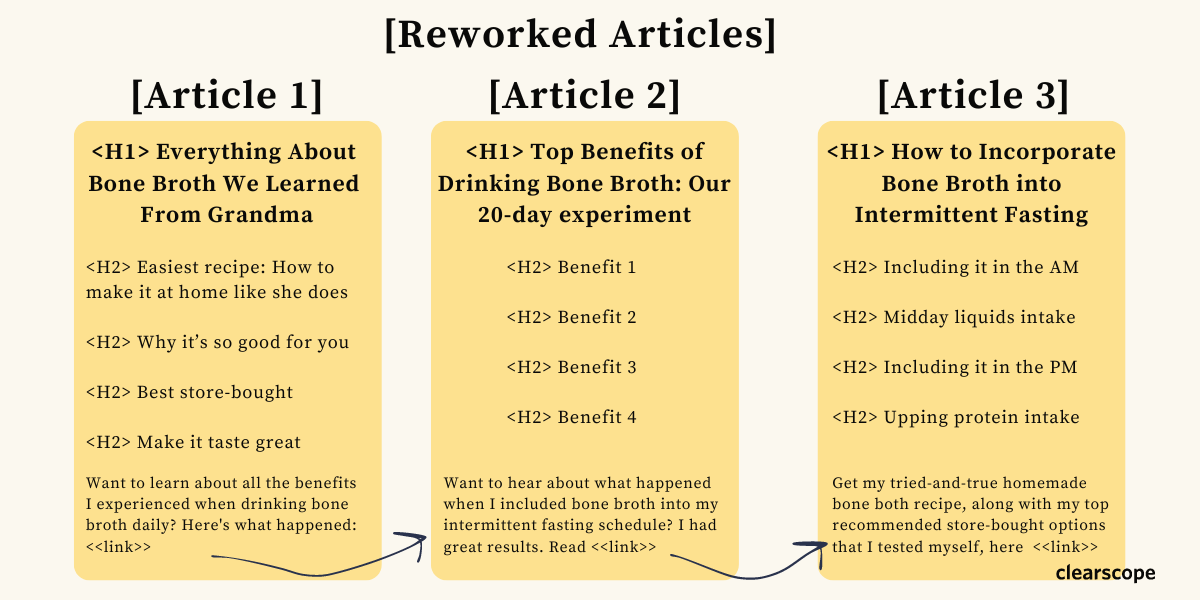
You now have a little mini topic cluster that better serves readers because the pieces now:
Are easier to read or scan
Meet targeted, specific search intent
All of these pieces can (and should) now interlink with one another.
In fact, your [resources/bone-broth-guide/] URL can now contain a neat-and-tidy recommended reading list with these new articles.
Step 3: Create new content for zero-volume keywords
It can be a challenge to convince a team to go after keywords with predicted zero search volume.
This seems absolutely counterintuitive to everything most of us were taught about SEO.
But in the world of information gain, going after zero-volume keywords makes absolute sense.
Many times, zero-volume keywords signal topics that are just on the horizon of interest. By targeting these keywords early on, you can establish a presence before the competition intensifies.
After you’ve refreshed your existing content—and while you're reworking those 5 test articles to include information gain—choose 2-3 zero-volume keywords in your target topics to create new content around.
You might be surprised at the results, and it’s a wise way to continue building authority in your topic niche while providing information gain.
Zero-volume keyword example
Let's take the search query [how to start keto diet] for example. One of the top search results offers this perspective:
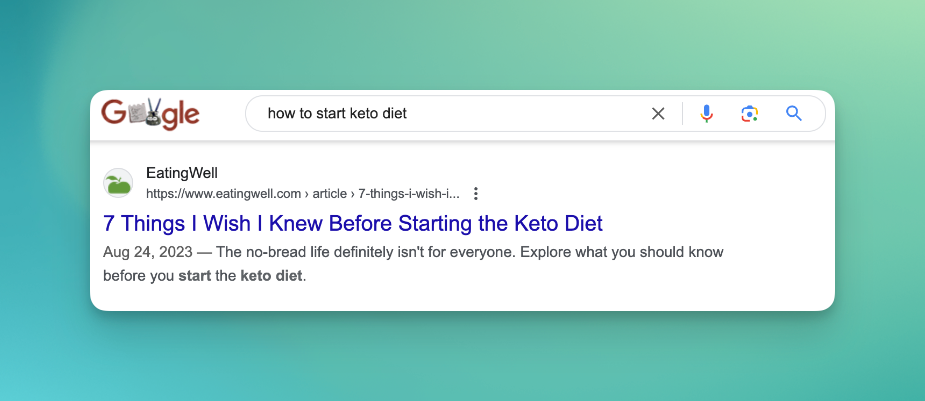
The EatingWell article "7 Things I Wish I Knew Before Starting the Keto Diet" is on the first page of search results for [how to start keto diet]. Note this article provides perspective-driven content.
In the result for the search query [how to start keto diet], Google is prioritizing a personal account of what to consider before beginning the diet.
However, when looking closer at the keywords in the title in Clearscope's Topic Exploration tool, we find out the perspective-driven keyword has zero estimated search volume.
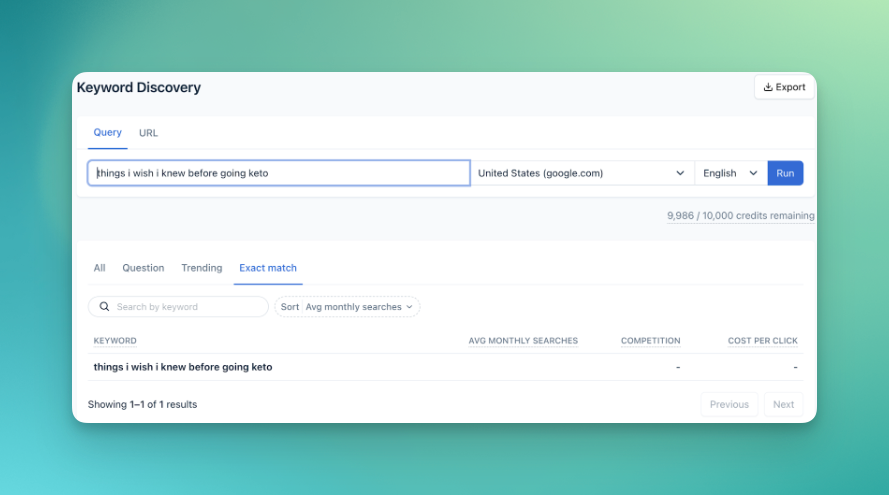
Clearscope's Topic Exploration shows [things I wish I knew before going keto] has zero search volume. However, the EatingWell article shows up on the first page of search results for the more competitive, higher volume keyword.
This is just one example that demonstrates when you target queries with a more niche search intent—that are often also queries with an estimated zero monthly search volume—you can compete on Page 1 based on what search engines determine best serves users.
Step 4: Monitor and record results
Once you publish your tests and new content, set reminders in your project management software to observe results after 1 month, 3 months, and 6 months.
And if you need a shorter, faster test? Adjust these check-in times accordingly.
At your timed checkups, record the metrics outlined in Step 1. Refresh and tweak content as needed to continue to seek top rankings.
For your zero-volume keyword content pieces, pay attention to when they started ranking and what related keywords they’re ranking for. How long did it take you to get to Page 1? Do they actually have zero-volume traffic?
If you used a few of the seven Ranch-style SEO content frameworks, test the content pieces within your email list and social channels. Note the following:
Which ones get the most organic engagement on social channels?
Which content frameworks produce the most newsletter engagement?
Which perspectives resonate with your current audience?
Which perspectives garner new followers or newsletter signups?
Phase 3: Take action on your learning
If you’ve completed the first two phases—collecting current first-party information you have on hand to refresh existing content and testing and monitor outcomes—it’s time to take what you’ve learned and put it to work.
What worked well for you from your testing and monitoring in Phase 2?
What perspectives or content frameworks resonate the most with your target audience?
What kind of data-sharing or storytelling produces the best results for your sales and marketing goals?
Does your target audience prefer survey data (who doesn’t—data is sexy, right?), case studies, or interviews?
To put it simply: Whatever is working—well—do more of that.
To make sure that happens, we recommend:
Creating ways to strategically and regularly capture new primary data
Investing in different types of first-party research or information creation
Step 1: Create ways to continually capture new information from customers
Create a program or system to continue to capture feedback from your customers.
Or explore establishing a user-generated content program if it suits your audience and business structure; that way, you’re creating new content with fresh perspectives at scale.
(You can also design ways to capture new information in Phase 1 to get the ball rolling if you don’t have any primary-source or first-party data. But creating a program after testing in Phase 2 can help inform a better system.)
If you’re an e-commerce company, it’s likely you already have some of this built-in via reviews.
If you’re not an e-commerce company, you’ll need your customer or sales teams to do reach-outs, create regular opportunities for feedback, and honor your customers that provide their precious time giving feedback—whether it’s negative or positive.
And if you don’t have a team of support? You can simply capture emails and comments you get from readers when they send you feedback directly.
Interested in UCG content for SEO? Check out this Clearscope Webinar led by Tory Gray of The Gray Dot Co.
Step 2: Invest in different types of new information
If information-gain content is working for you, invest in the type of data or interviews your target audience wants in addition to regularly capturing customer information and testimonials.
When building out your content strategy, plan time for:
Interviewing outside experts
Telling a related story
Creating video
Completing robust analyses
Collecting meaningful data
Running tests and surveys
Building case studies
That way, you’re not just simply refreshing your existing content inventory with dialogue, first-person experiences, and quotes one time and then moving on.
If you’ve made it through Phase 3, you’re on your way to regularly exhibiting your authority through providing new data and perspectives, something we all know AI cannot easily replicate.
Ready to learn more about information gain and why it’s essential to the future of your content strategy?
Check out The Difference Between Topical Authority vs. Information Gain or Information Gain SEO and Your Long-Tail Keyword Strategy: How They Work Together.
A huge thank-you to Bernard Huang of Clearscope, Garrett Sussman of iPullRank, Tory Gray of The Gray Dot Co., and Kevin Indig of The Growth Memo for reviewing this piece and providing their invaluable, intelligent feedback. Go give them each a follow!
How to Implement Ranch-Style SEO: 7 Successful Frameworks
Learn 7 successful content frameworks for Ranch-Style SEO, the future-proof, perspective-driven SEO strategy that’ll take your site into the next era of search.
Read moreInformation Gain in SEO: The Guide to Convincing Yourself, Team, and Clients to Rethink Current Strategies
What is information gain? Why is everyone talking about it? This is the guide you need to persuade yourself, your team, and your clients to reassess your current strategy to include info gain in your content.
Read moreTopical authority vs. information gain (with examples)
Discover the differences between the SEO concepts of topical authority and information gain. Examples of each are included.
Read more